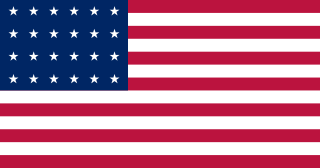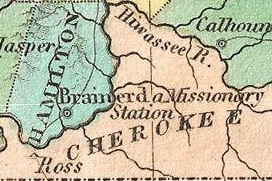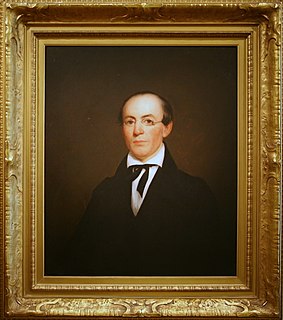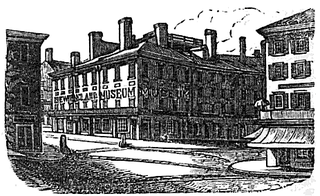 W
WThe Territory of Arkansas, officially the Territory of Arkansaw, and commonly known as the Arkansas Territory or the Arkansaw Territory, was an organized incorporated territory of the United States that existed from July 4, 1819, to June 15, 1836, when the final extent of Arkansas Territory was admitted to the Union as the State of Arkansas. Arkansas Post was the first territorial capital (1819–1821) and Little Rock was the second (1821–1836).
 W
WThe Aroostook War was a military and civilian-involved confrontation in 1838–1839 between the United States and the United Kingdom over the international boundary between the British colony of New Brunswick and the U.S. state of Maine. Two Canadian militiamen were injured by black bears before top-level diplomats from the U.S. and Britain met in Washington and forged a peaceful compromise. The Webster–Ashburton Treaty of 1842 settled the border along the line it still holds today. The term "war" was rhetorical; local militia units were called out but never engaged in actual combat. The event is best described as an international incident.
 W
WThe Boston Female Anti-Slavery Society (1833–1840) was an abolitionist, interracial organization in Boston, Massachusetts, in the mid-19th century. "During its brief history ... it orchestrated three national women's conventions, organized a multistate petition campaign, sued southerners who brought slaves into Boston, and sponsored elaborate, profitable fundraisers."
 W
WCherokee removal, part of the Trail of Tears, refers to the forced relocation between 1836 and 1839 of an estimated 16,000 members of the Cherokee Nation and 1,000-2,000 of their slaves; from their lands in Georgia, South Carolina, North Carolina, Tennessee, and Alabama to the Indian Territory in the then Western United States, and the resultant deaths along the way and at the end of the movement of an estimated 4,000 Cherokee and unknown number of slaves.
 W
WThe Creek "War" of 1836, also known as the Second Creek War or Creek Alabama Uprising, was a conflict in Alabama at the time of Indian Removal between the Muscogee Creek people and non-native land speculators and squatters.
 W
WHarding's Gallery in Boston, Massachusetts, exhibited works by European and American artists in the 1830s-1840s. The building on School Street also housed a newspaper press; the Mercantile Library Association; the Boston Artists' Association; and artists' studios. The building's name derived from painter Chester Harding, who kept his studio there.
 W
WGeorge Washington, elected the first president in 1789, worked with the heads of the departments of State, Treasury, and War, along with an Attorney General, the group of which later became known as his cabinet. Based in New York, the new government acted quickly to rebuild the nation's financial structure. Enacting the program of Treasury Secretary Alexander Hamilton, the government assumed the Revolutionary War debts of the states and the national government, and refinanced them with new federal bonds. It paid for the program through new tariffs and taxes; the tax on whiskey led to a revolt in the west; Washington raised an army and suppressed it. The nation adopted a Bill of Rights as 10 amendments to the new constitution. Fleshing out the Constitution's specification of the judiciary as capped by a Supreme Court, the Judiciary Act of 1789 established the entire federal judiciary. The Supreme Court became important under the leadership of Chief Justice John Marshall (1801–1835), a federalist and nationalist who built a strong Supreme Court and strengthened the national government.
 W
WThe Republic of Indian Stream or Indian Stream Republic was an unrecognized constitutional republic in North America, along the section of the border that divides the current Canadian province of Quebec from the U.S. state of New Hampshire. It existed from July 9, 1832, to August 5, 1835. Described as "Indian Stream Territory, so-called" by the United States census-taker in 1830, the area was named for Indian Stream, a small watercourse. It had an organized elected government and constitution and served about three hundred citizens.
 W
WThe presidency of Andrew Jackson began on March 4, 1829, when Andrew Jackson was inaugurated as President of the United States, and ended on March 4, 1837. Jackson, the seventh United States president, took office after defeating incumbent President John Quincy Adams in the bitterly contested 1828 presidential election. During the 1828 presidential campaign, Jackson founded the political force that coalesced into the Democratic Party during Jackson's presidency. Jackson won re-election in 1832, defeating National Republican candidate Henry Clay by a wide margin. He was succeeded by his hand-picked successor, Vice President Martin Van Buren, after Van Buren won the 1836 presidential election.
 W
WThe Locofocos were a faction of the United States Democratic Party that existed from 1835 until the mid-1840s.
 W
WThe Massachusetts Anti-Slavery Society, headquartered in Boston, was organized as an auxiliary of the American Anti-Slavery Society in 1835. Its roots were in the New England Anti-Slavery Society, organized by William Lloyd Garrison, editor of The Liberator, in 1831, after the defeat of a proposal for a college for blacks in New Haven.
 W
WThe New-England Museum in Boston, Massachusetts, was established at 76 Court Street by Ethan A. Greenwood, Peter B. Bazin, John Dwight and Samuel Jackson. It featured displays of fine art, natural history specimens, wax figures, and other curiosities. Bands of musicians typically performed there during public hours.
 W
WPendleton's Lithography (1825–1836) was a lithographic print studio in 19th-century Boston, Massachusetts, established by brothers William S. Pendleton (1795-1879) and John B. Pendleton (1798-1866). Though relatively short-lived, in its time the firm was prolific, printing portraits, landscape views, sheet music covers, and numerous other illustrations. The Pendleton's work might be characterized by its generosity—each print contains a maxima of visual information designed for graphic reproduction.
 W
WThe presidency of Martin Van Buren began on March 4, 1837, when Martin Van Buren was inaugurated as President of the United States, and ended on March 4, 1841. Van Buren, the incumbent Vice President and chosen successor of President Andrew Jackson, took office as the eighth United States president after defeating multiple Whig Party candidates in the 1836 presidential election. A member of the Democratic Party, Van Buren's presidency ended following his defeat by Whig candidate William Henry Harrison in the 1840 presidential election.
 W
WThe life of Joseph Smith, Jr. from 1831 to 1834, when he was 26–29 years old, covers the period of time from when Smith moved with his family to Kirtland, Ohio, in 1831, to his return from Zion's Camp in 1834. By 1831, Smith had already translated the Book of Mormon, and established the Latter Day Saint movement. He had founded it as the Church of Christ, but was eventually instructed by revelation to change its name to the Church of Jesus Christ of Latter Day Saints.
 W
WThe Taney Court refers to the Supreme Court of the United States from 1836 to 1864, when Roger Taney served as the fifth Chief Justice of the United States. Taney succeeded John Marshall as Chief Justice after Marshall's death in 1835. Taney served as Chief Justice until his death in 1864, at which point Salmon P. Chase took office. Taney had been an important member of Andrew Jackson's administration, an advocate of Jacksonian democracy, and had played a major role in the Bank War, during which Taney wrote a memo questioning the Supreme Court's power of judicial review. However, the Taney Court did not strongly break from the decisions and precedents of the Marshall Court, as it continued to uphold a strong federal government with an independent judiciary. Most of the Taney Court's holdings are overshadowed by the decision in Dred Scott v. Sandford, in which the court ruled that African-Americans could not be citizens. However, the Taney Court's decisions regarding economic issues and separation of powers set important precedents, and the Taney Court has been lauded for its ability to adapt regulatory law to a country undergoing remarkable technological and economic progress.
 W
WThe Temple School (1834-ca.1841), in Boston, Massachusetts, USA, was established by Amos Bronson Alcott and Elizabeth Palmer Peabody in 1834, and featured a teaching style based on conversation. Teachers working at the school included Elizabeth Peabody and Margaret Fuller.
 W
WThe Treaty of Pontotoc Creek was a treaty signed on October 20, 1832 by representatives of the United States and the Chiefs of the Chickasaw Nation assembled at the National Council House on Pontotoc Creek, Mississippi. The treaty ceded the 6,283,804 million acres of the remaining Chickasaw homeland in Mississippi in return for Chickasaw relocation on an equal amount of land west of the Mississippi River.